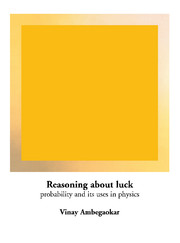Book contents
- Frontmatter
- Contents
- Preface
- 1 Introduction
- 2 The likely, the unlikely, and the incomprehensible
- 3 Normality and large numbers
- 4 Examples
- 5 A little mathematics
- 6 Forces, motion, and energy
- 7 Atoms, molecules, and molecular motion
- 8 Disorder, entropy, energy, and temperature
- 9 Heat, work, and putting heat to work
- 10 Fluctuations and the arrow of time
- 11 Chaos
- 12 Quantum jumps: the ultimate gamble
- Index
3 - Normality and large numbers
- Frontmatter
- Contents
- Preface
- 1 Introduction
- 2 The likely, the unlikely, and the incomprehensible
- 3 Normality and large numbers
- 4 Examples
- 5 A little mathematics
- 6 Forces, motion, and energy
- 7 Atoms, molecules, and molecular motion
- 8 Disorder, entropy, energy, and temperature
- 9 Heat, work, and putting heat to work
- 10 Fluctuations and the arrow of time
- 11 Chaos
- 12 Quantum jumps: the ultimate gamble
- Index
Summary
… to be abnormal is to be detested.
Ambrose BierceThe subject of probability is made particularly interesting and useful by certain universal features that appear when an experiment with random outcomes is tried a large number of times. This topic is developed intuitively here. We shall play with an example used in Chapter 2 and, after extracting the general pattern from the particular case, we shall infer the remarkable fact that only a very small fraction of the possible outcomes associated with many trials has a reasonable likelihood of occurring. This principle is at the root of the statistical regularities on which the banking and insurance industries, heat engines, chemistry and much of physics, and to some extent life itself depend. A relatively simple mathematical phenomenon has such far reaching consequences because, in a manner to be made clear in this chapter, it is the agency through which certainty almost re-emerges from uncertainty,
The binomial distribution
To illustrate these ideas, we will go back to rolling our hypothetical fair dice. Following the example of the dissolute French noblemen of the seventeenth century, one of whose games we analyzed in such detail in the last chapter, we shall classify outcomes for each die into the mutually exclusive categories ‘six’ and ‘not-six’, which exhaust all possibilities. If the repeatable experiment consists of rolling a single die, the probabilities for these two outcomes are the numbers 1/6 = 0.16667 and 5/6 = 0.83333.
- Type
- Chapter
- Information
- Reasoning about LuckProbability and its Uses in Physics, pp. 23 - 47Publisher: Cambridge University PressPrint publication year: 1996

